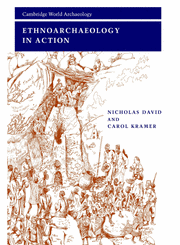Book contents
- Frontmatter
- Dedication
- Contents
- List of figures and credits
- List of tables
- Preface
- Acknowledgments
- Map
- 1 Ethnoarchaeology: its nature, origins, and history
- 2 Theorizing ethnoarchaeology and analogy
- 3 Fieldwork and ethics
- 4 Human residues: entering the archaeological context
- 5 Fauna and subsistence
- 6 Studying artifacts: functions, operating sequences, taxonomy
- 7 Style and the marking of boundaries: contrasting regional studies
- 8 Settlement: systems and patterns
- 9 Site structures and activities
- 10 Architecture
- 11 Specialist craft production and apprenticeship
- 12 Trade and exchange
- 13 Mortuary practices, status, ideology, and systems of thought
- 14 Conclusions: ethnoarchaeology in context
- Bibliography
- Index
12 - Trade and exchange
Published online by Cambridge University Press: 05 March 2015
- Frontmatter
- Dedication
- Contents
- List of figures and credits
- List of tables
- Preface
- Acknowledgments
- Map
- 1 Ethnoarchaeology: its nature, origins, and history
- 2 Theorizing ethnoarchaeology and analogy
- 3 Fieldwork and ethics
- 4 Human residues: entering the archaeological context
- 5 Fauna and subsistence
- 6 Studying artifacts: functions, operating sequences, taxonomy
- 7 Style and the marking of boundaries: contrasting regional studies
- 8 Settlement: systems and patterns
- 9 Site structures and activities
- 10 Architecture
- 11 Specialist craft production and apprenticeship
- 12 Trade and exchange
- 13 Mortuary practices, status, ideology, and systems of thought
- 14 Conclusions: ethnoarchaeology in context
- Bibliography
- Index
Summary
Specific types of exchange and interaction are characteristic of various levels of sociocultural complexity.
(Kent Flannery 1972: 129)To avoid the chaos that would result if they were obliged to redistribute all materials to all of the populace at feasts, the elites developed market institutions.
(Brian Hayden 1993: 405)We left Sirjan for Kirman yesterday on a truckload of dried limes … going to Tehran and had to change over to a truckload of stovewood … We searched the bazaar and found plenty of large still-fresh muskmelons, in form and size much like those that are sent from Kabul to India, but these are sweeter. They are a common item of the fruit trade in the capital, and every Tehrani will accordingly tell you that the country's best muskmelons come from Isfahan. Anyone who has ever been in Khorasan will have quite a different opinion.
(Walter N. Koelz 1983:18, 48)In this chapter we consider ethnoarchaeological studies of trade and exchange, processes repeatedly implicated by archaeologists in the development of complex societies and societal evolution. Of the limited number available we choose five for special attention. These cover a wide range of socioeconomic complexity.
Exchange, trade, and distribution
Let us use “exchange” as a general term for the transfer of goods and services between people, reserving “trade” for forms that involve at least part-time specialists.
- Type
- Chapter
- Information
- Ethnoarchaeology in Action , pp. 360 - 377Publisher: Cambridge University PressPrint publication year: 2001

